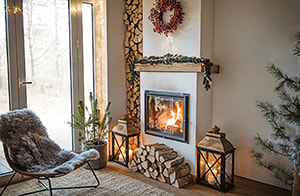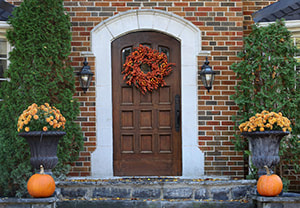 Quickly transition from winter to spring by changing out these three pieces of home decor. Replace Front Door Decoration Three months ago, the Fraser fir wreath decorated with miniature packages looked adorable on your front door. Now the pine needles and faux berries are out of season, and if it's made of real foliage, it's dried and wilted. Freshen up your front door with a beautiful seasonal wreath made of eucalyptus leaves or wildflowers. Baby's breath, moss, and grapevine are some other materials that add an inviting spring vibe. Add potted plants to your front porch entrance to make it more welcoming. Change Out Pillows Decorative pillows are an inexpensive way to update your living room or bedroom. Heavy, rich fabrics and patterns in plaids and shades of red and green are appropriate for the winter season, but lighter materials in brighter colors and patterns are perfect for spring. Pillows with florals, birds, and farmhouse designs add a touch of whimsy. White is another great option to brighten up your home, and you can even get pillow covers with cute sayings such as "Think Spring" or "Hop to It." You don't have to get overly feminine pillows if that's not your style?there are plenty of more neutral options that are still bright and airy and reminiscent of spring. Add Sheer Curtains During the winter season, blackout curtains and heavy drapes add insulation around drafty windows; they can also block out midafternoon heat in the summer. But blackout curtains make rooms feel dark and block out natural sunlight in rooms that don't get direct sun. If you love your blackout curtains, go ahead and keep them, but consider putting up sheers in rooms that need more natural light, or at least change out dark-colored drapes to lighter ones.
0 Comments
 Open floor plans, soaring ceilings, and expansive, arched doorways lend an airy, spacious feel to a house. While not every home boasts these features, there’s no need to settle. If your rooms feel cramped, consider these strategies to create the illusion of more space. Light Paint Palette While decor magazines and designers may suggest intricate color schemes and even ceiling patterns, in reality, painting the ceiling of a smaller room anything other than a light shade can diminish its perceived size. Opt for various shades of white to brighten the space and give the ceiling a loftier appearance. Multisource Lighting Dimly lit rooms can induce feelings of confinement. In addition to an overhead light, consider placing floor or table lamps at opposite corners of the room. This balanced lighting approach will make the entire area appear brighter, more inviting, and more spacious. Minimal Window Dressings Natural light breathes life into a room and imparts a sense of spaciousness. Remove heavy curtains or decorative fixtures from your windows to maximize the room’s exposure to natural light. If you must have curtains, choose a sheer fabric that will allow more daylight to pass through. Simplified Wall Decor While posters, artwork, photographs, and shelves offer opportunities for personal expression, an excess of wall clutter can make a space feel confined. Select a few tasteful items and hang them higher on the wall. This draws the eye upward, creating an added sense of height. Sofa Spacing Resist the urge to push all furniture against the walls in an attempt to maximize space. This can actually make the area feel cramped. Instead, try angling furniture away from the walls or pulling it slightly forward. Allowing some space between the furniture and the walls creates a more open and inviting atmosphere. Mirror Magic Although they can’t quite perform magic, mirrors come close by expanding a room’s visual footprint. By strategically placing a large mirror facing a window, you can create the illusion of additional space and amplify the natural light, effectively doubling its impact. By incorporating these strategies, you can effectively create the illusion of a larger, more open space within your home. You might be pleasantly surprised to discover just how much roomier it feels.  When looking for a home, one common piece of advice is to choose a property that will appreciate in value. However, value is subjective. For example, a dream home with an in-ground pool for one person might be a hassle for another. These three house hunting tips will aid you in objectively assessing a property’s potential and identifying the assets that tend to appreciate in value the most. Look for Hidden Gem Neighborhoods Some house hunters search for neighborhoods that have already become popular, but buying in a hot neighborhood means you’ve missed out on much of the appreciation. These homes have already seen a boost in value due to the appeal of the area. To find a home that will appreciate in value, focus on neighborhoods with moderately priced houses showing signs of potential growth: well-kept homes, low crime rates, and close proximity to schools or parks. Purchasing before the neighborhood gains popularity ensures you’ll maximize your potential profit. Find the Perfect Fixer-Upper It’s common knowledge that fixer-uppers can be a good investment, but take note: Not everyone is willing to put in the work themselves or able to pay for needed repairs. Some fixer-uppers also have too many issues, such as foundation or structural problems, so you would not be able to recoup your expenses when selling the home. Search for homes that need only cosmetic improvements. The key to finding a worthwhile fixer-upper is to know what tasks you’re willing to do yourself and when you need to call in a professional. Evaluate potential gains by crunching numbers before putting in an offer. Avoid making an offer if a property requires more work than you’re financially prepared to undertake. Prioritize Amenities and Curb Appeal Look for a home with amenities that are always in demand, such as a nice yard, patio, or front yard flower garden. Often, it only takes a fresh coat of paint or a little bit of staging—such as setting out potted plants or patio furniture—to boost curb appeal and entice buyers. Homes near parks, schools, or other local amenities also attract buyers and have a built-in value. Consider the house hunting process through the lens of what your home will be worth in the future. Will it increase in value to make you a considerable profit? Look for attributes that are attractive to a wide range of buyers to help narrow down your search and give you confidence in your new home.  Technology has transformed the way homes are appraised, and a new set of rules has emerged for sellers looking to maximize their home’s appraisal value. Understanding modern appraisals is essential, as appraisal value is critical in determining a home’s asking price. Traditionally, home appraisals were done manually by professionals who used their expertise to evaluate properties based on location, size, condition, and market trends. Appraising a home was a mixture between the subjective and the objective, and it often came down to a personal decision by the appraiser. The New Appraisal Landscape Traditional appraisals are being replaced by automation. According to a report by analytics firm CoreLogic, an estimated 70% of residential property valuations in the U.S. are conducted using automatic valuation models (AVMs). AVMs are computer programs that use a property’s data, such as its location, size, age, and historical sales, to estimate the property’s value. The newest AVMs incorporate algorithms that use complex mathematical models to analyze every last piece of available data about a property; this predicts the current and future value with even higher levels of precision. AVMs Need Accurate Data The most important step homeowners can take to prepare for an AVM-based valuation is to ensure their property information is accurate in all government records and also in any informal online listings. This is especially important for older homes whose improvements and renovations might not be reflected in public property records. AVMs have the ability to read the internet, so the more positive data about a property, the better. Make sure any unique features or amenities are thoroughly described in all records. Be Aware That AVMs Have Limitations AVMs may not capture certain aspects of a property, such as its unique features or intangible benefits that are not fully reflected in property records. In these cases, it may be necessary to supplement an AVM with a traditional appraisal. When selecting a traditional appraiser, look for professionals with local experience who will appreciate the holistic value of a home, including less-tangible factors like the view, architectural features, or other aesthetic qualities. New technology always has drawbacks. AVMs aim to eliminate guesswork from home appraisals, but in reality, the human factor always plays a crucial role in determining a home’s actual value. If you’re ready to buy or sell, reach out today! I can help you get the best price for your property in the current market.  Existing-home sales saw a decline in June, with every sales region across the country reporting drops in year-over-year sales. However, according to the National Association of Realtors (NAR), month-over-month sales were more variable, with increases in the Northeast, decreases in the South and West, and stability in the Midwest. Home prices, meanwhile, held firm in most regions of the country. According to Lawrence Yun, chief economist for NAR, “limited supply is still leading to multiple-offer situations, with one-third of homes getting sold above the list price in the latest month.” Who’s Buying Homes? First-time buyers accounted for 27% of all sales in June, down from 28% a month earlier and 30% a year earlier. All-cash sales, meanwhile, made up 26% of all transactions, up from 25% both a month ago and a year ago. Two groups responsible for many all-cash purchases—namely, individual investors and second-home buyers—saw potential in the housing market; these groups purchased 18% of homes in June, up from 15% in May 2023 and 16% in June 2022. The average property remained available for sale for 18 days in June 2023, unchanged from a month earlier and up from 14 days a year earlier. Of all the homes sold in June, 76% were available for under one month. Twice as Much Inventory Needed Although the first half of 2023 was negative for the housing market, with sales down by 23%, economists believe change is coming. “Fewer Americans were on the move despite the usual life-changing circumstances,” Yun hypothesized. “The pent-up demand will surely be released soon, especially if mortgage rates and inventory move favorably.” Yet, by the end of June, total housing inventory sat at 1.08 million units, unchanged from May and down 13.6% from June 2022. At the current sales pace, this level of inventory would supply the market for 3.1 months, up from a 3-month supply in May and down from a 2.9-month supply in June 2022. For market conditions to improve, there needs to be an increase in inventory; according to Yun, the “market can easily absorb a doubling of inventory.” Regional Breakdown Northeast - Existing-home sales annual rate of 510,000; an increase of 2% from May 2023 but a decrease of 21.5% from June 2022. The median sales price of $475,300 represented an increase of 4.9% from June 2022. Midwest - Existing-home sales annual rate of 990,000; unchanged from May 2023 but a decrease of 19.5% from June 2022. The median sales price of $311,800 represented an increase of 2.1% from June 2022. South - Existing-home sales annual rate of 1.91 million; a decrease of 5.4% from May 2023 and 16.2% from June 2022. The median sales price of $366,600 represented a decrease of 1.2% from June 2022. West - Existing-home sales annual rate of 750,000; a decrease of 5.1% from May 2023 and 22.7% from June 2022. The median sales price of $606,500 represented a decrease of 3.4% from June 2022.  Use these tips to create an aesthetically pleasing landscape while also being mindful of water conservation. Choose Native and Drought-Resistant Plants Opt for plant species that are native to your region and can thrive with minimal watering once they are established. These plants are adapted to the local climate and require less maintenance. Utilize Compost and Mulch Enhance water retention around plant roots by incorporating compost into the soil during planting. Cover the area with a layer of mulch to reduce evaporation. Leave some space around the base of each plant and avoid creating mulch mounds around trees and plants. Water Deeply and Infrequently Instead of frequent light watering, provide deep soakings to your plants. This encourages deeper root growth and reduces water loss through evaporation. Watering less often but more deeply also promotes healthier and more resilient plants. Minimize Your Lawn Area Lawns consume a significant amount of water. Consider reducing the size of your lawn by replacing portions of it with drought-resistant ground cover that requires no mowing. This saves water and reduces maintenance efforts. Use Gray Water and Rainwater Install systems to collect and reuse gray water from activities such as laundry and dishwashing, as well as rainwater for irrigation. These sustainable methods provide a free source of water for your landscape and reduce the need for fresh water. Install a Drip Irrigation System Drip irrigation systems deliver water directly to the root zone of plants, minimizing water waste through evaporation and runoff. Compared to traditional sprinkler systems, they can save 20% to 50% more water. Consider adding a timer to ensure efficient watering. Conserving water not only benefits the environment but also reduces your water bills in the long run.  Buying a home can be an expensive process. Enter seller concessions: These are costs associated with purchasing a home that a seller agrees to pay for the buyer. Rather than a buyer paying for these out-of-pocket expenses themselves, the seller agrees to cover the cost, allowing homeowners to sell their home quicker while helping to ease the financial burden on buyers. How Do Concessions Benefit Sellers? Buyers receive a clear benefit from concessions—they can save money when purchasing their new home. However, sellers can also benefit from offering concessions. In a buyers’ market, concessions may help attract more potential buyers, increasing the odds of a sale. In a high-price/high-interest market, concessions can make a property more appealing by presenting it as a more affordable option than the competition. A motivated seller can offer concessions to reduce the amount of time their property will likely remain on the market. Types of Seller Concessions Out-of-pocket expenses: Commonly known as closing costs, these include appraisal fees, mortgage origination fees, property taxes, title fees, discount points, processing fees, inspection fees, insurance, attorney fees, and HOA fees. Buydowns: A less common concession, in which sellers temporarily lower the interest rate on the buyer’s behalf to make the property more attractive in a competitive market. Repairs: Sellers may offer concessions to cover the costs of any necessary repairs the property requires before closing. Contribution Guidelines It is important for sellers to be aware of the limitations on the concessions they can offer. The concession amount should never exceed the buyer’s closing costs. Additionally, different types of loans have varying guidelines for seller contributions. Conventional loans: The concession amount will depend on the down payment size. Investment properties: Concessions are capped at 2%. Federal Housing Administration (FHA) and U.S. Department of Agriculture (USDA) loans: Seller concessions are capped at 6%, regardless of the down payment size. Veterans Affairs (VA) loans: Seller concessions are capped at up to 4% of the loan amount and can include regular closing costs, prepaids, consumer debt, and funding fees. Seller concessions play a crucial role in real estate transactions, but navigating them can be tricky. That’s why it’s important for sellers to seek expert advice from a real estate professional who can help them make informed decisions. |
AuthorBe informed with the latest real estate news and useful real estate related information. Archives
March 2025
Categories
|
